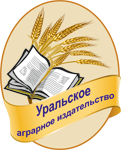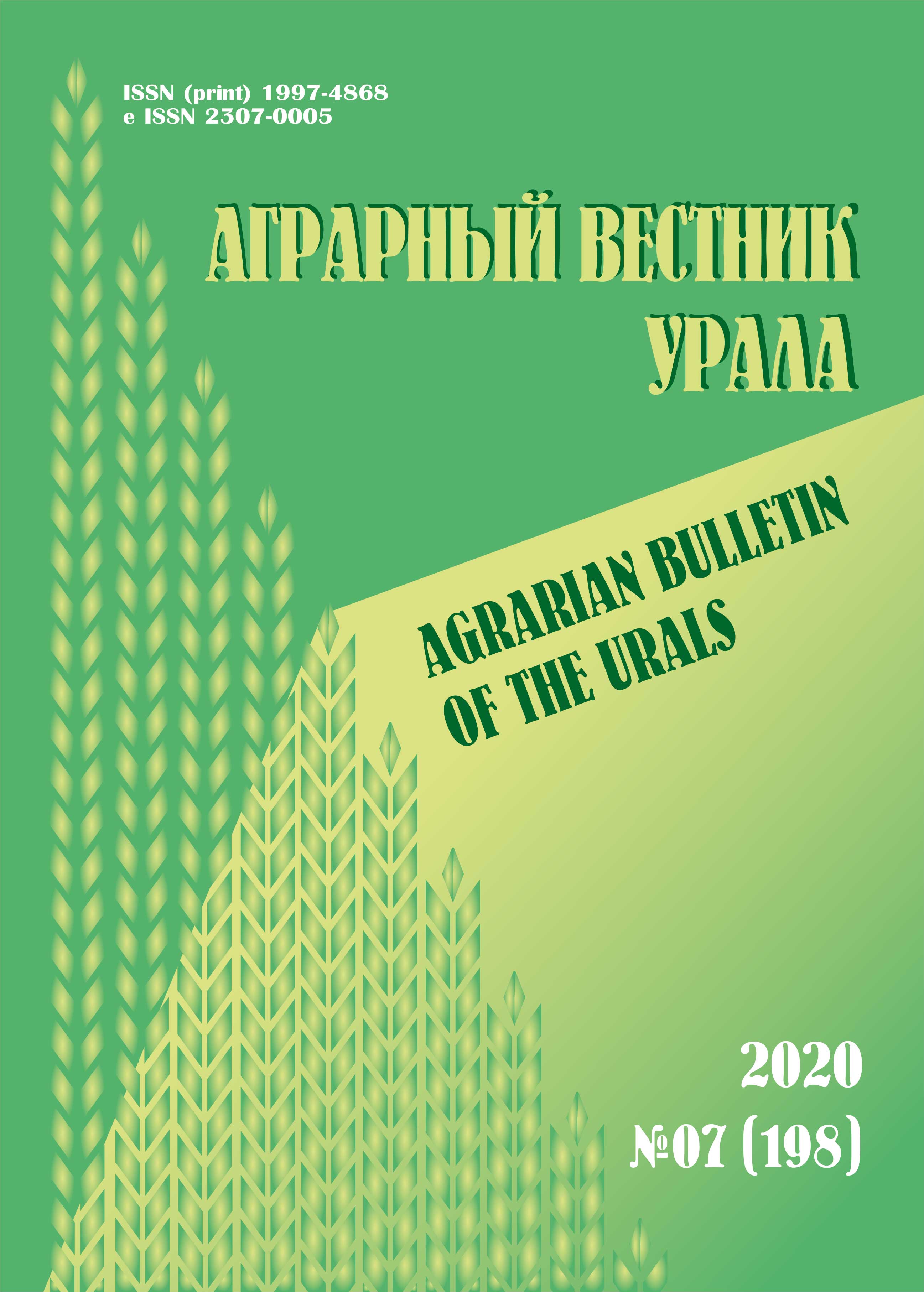Orenburg, Orenburg, Russian Federation
Orenburg, Orenburg, Russian Federation
Abstract. The aim of research is to monitor the genetic diversity of Kazakh White-Headed breed, taking into account the GH L127V and GHR F279Y polymorphisms. Research methods. The object of the study were cows (n = 57 heads) and young animals (calves and heifers, n = 50 heads) from the breeding farm “Krasnyy Oktyabr’”, Volgograd region. Whole blood of animals served as the biomaterial; genotyping was carried out according to the polymorphisms GH L127V in growth hormone gene and GHR F279Y in growth hormone receptor gene by PCR-RFLP method. Results. The study of the gene pool by polymorphisms of the somatotropic axis genes in Kazakh White-Headed cattle showed that the representatives of mature herd and young animals had L (PL = 0.660–0.728) and V (PV = 0.272–0.340) alleles in the locus of growth hormone gene, as well as F (PF = 0.412–0.550) and Y (PY = 0.450–0.588) in the locus of growth hormone receptor gene. Genotypes distribution in growth hormone gene polymorphism was more balanced according to the Hardy-Weinberg law, but the population significantly (P < 0.05) deviated from the equilibrium state according to the genetic frequencies in growth hormone receptor gene. Differences in genetic frequencies for the growth hormone gene did not reach a significant level (χ2 = 4.451; P = 0.108) between cows and young animals. Whereas, there were significant differences (χ2 = 12.103; P = 0.002) in the frequencies of homozygous genotypes carriers for the growth hormone receptor gene, which was due to the use of heterozygous sire for this polymorphism in the reproduction of the herd. Scientific novelty. For the first time, data on the assessment of the genetic structure of the Kazakh White-Headed mature herd and replacement young animals of Volgograd selection were obtained according to the polymorphisms GH L127V and GHR F279Y, associated with indicators of meat productivity. The results of the analysis of the genetic structure of the herd indicate the possibility of directed changes in the gene pool of the population in just one generation, which creates the prerequisites for the introduction of marker-assisted selection.
Kazakh White-Headed breed, cows, young animal, genotype, allele, variability, polymorphism, GH L127V, GHR F279Y
1. Beketov S. V., Piskunov A. K., Voronkova V. N., Stolpovsky Y. A., Petrov S. N., Kharzinova V. R., Dotsev A. V., Zinovieva N. A., Selionova M. I. Geneticheskoe raznoobrazie i filogeniya pukhovykh koz Tsentral’noy i Sredney Azii [Genetic diversity and phylogeny of fleece-bearing goats of Central and Middle Asia] // Russian Journal of Genetics. 2021. Vol. 57. No. 7. Pp. 816-824. (In Russian.) DOI: https://doi.org/10.1134/S1022795421070036; EDN: https://elibrary.ru/WPOZTR
2. Otarov A. I., Kayumov F. G., Tretyakova R. Rost, razvitiye i myasnyye kachestva chistoporodnykh i pomesnykh bychkov pri otkorme na ploshchadke v zavisimosti ot sezona goda [Growth, development and meat qualities of purebred and crossbred bulls when feeding on the site, depending on the season of the year] // Izvestia Orenburg State Agrarian University. 2021. No. 3 (89). Pp. 267-272. (In Russian.) DOI: https://doi.org/10.37670/2073-0853-2021-89-3-267-272; EDN: https://elibrary.ru/SYHJAQ
3. Dzhulamanov K. M., Gerasimov N. P., Dubovskova M. P., Baktygalieva A. T. Polymorphisms of CAPN1, CAST, GDF5, TG5 and GH genes in Russian Hereford cattle // Bulgarian Journal of Agricultural Science. 2019. Vol. 25. No. 2. Pp. 375-379. EDN: https://elibrary.ru/ZBWIXR
4. Dubovskova M. Osobennosti selektsii skota gerefordskoy porody vnutriporodnogo tipa Dmitriyevskiy severo-kavkazskoy populyatsii s uchetom polimorfizma GH (L127V) i LEP/A80V [Breeding peculiarities of Hereford cattle of the intra-breed type Dmitrievsky, North Caucasian population, taking into account polymorphism GH (L127V) and LEP/A80V] // Animal Husbandry and Fodder Production. 2020. Vol. 103. No. 4. Pp. 85-95. (In Russian.)
5. Tyulebaev S. D., Stolpovskiy Yu.A., Lukyanov A. A., Litovchenko V. G., Koshcheeva A. V. K sozdaniyu novogo tipa myasnogo skota dlya severo-zapada i Tsentral’nykh regionov RF [To the creation of a new type of meat cattle for the Northwest and the Central regions of the Russian Federation] // Zootechniya. 2019. No. 1. Pp. 7-10. (In Russian.) DOI: https://doi.org/10.25708/ZT.2018.62.34.002; EDN: https://elibrary.ru/VXHQIY
6. Sedykh T. A., Gizatullin R. S., Dolmatova I. Yu., Gusev I. V., Kalashnikova L. A. Polimorfizm gena somatotropnogo gormona v svyazi s kachestvom tush myasnogo skota [Growth hormone gene polymorphism in relation to beef cattle carcass quality] // Russian Agricultural Sciences. 2020. Vol. 46. No. 3. Pp. 53-57. (In Russian.) DOI: https://doi.org/10.31857/S2500-2627-2020-2-53-57; EDN: https://elibrary.ru/KLUYDL
7. Fedota O. M., Ruban S. Yu., Lysenko N. G., Goraichuk I. V., Tyzhnenko T. V., Mitioglo L. V., Dzhus P. P., Birukova O. D. Analysis of SNPs F279Y and S555G in growth hormone receptor gene in beef and dairy cattle breeds // Journal for Veterinary Medicine, Biotechnology and Biosafety. 2017. Vol. 3. No. 2. Pp. 37-44. EDN: https://elibrary.ru/YUOMMR
8. Gontyurev V. A., Tyulebaev S. D., Makaev Sh. A. Rezul’taty otsenki sozdavaemykh novykh liniy kazakhskoy belogolovoy porody [The results of evaluation of the newly created lines of Kazakh White-Headed cattle] // Izvestiya Orenburg State Agrarian University. 2018. No. 3 (71). Pp. 207-210 (In Russian.) EDN: https://elibrary.ru/USUMHW
9. Khaynatskiy V. Yu., Gontyurev V. A., Dzhulamanov K. M., Iskanderova A. P., Tyulebaev S. D. Kazakhskaya belogolovaya - pervaya otechestvennaya spetsializirovannaya poroda myasnogo skota [The Kazakh White-Headed breed - the first domestic specialized a breed of beef cattle] // Dairy and beef cattle breeding. 2020. No. 2. Pp. 7-10. (In Russian.) DOI: https://doi.org/10.33943/MMS.2020.98.89.002; EDN: https://elibrary.ru/VHYEGS
10. Beishova I. S. Polimorfizmy genov somatotropinovogo kaskada, assotsiirovannyye s myasnoy produktivnost’yu korov kazakhskoy belogolovoy porody [The polymorphism of genes of the somatotrophic cascade associated with meat productivity in Kazakh White-headed cows] // Bulletin Samara State Agricultural Academy. 2018. No. 69 (1). Pp. 58-62. (In Russian.)
11. Selionova M. I., Plakhtyukova V. R. Myasnaya produktivnost’ bychkov kazakhskoy belogolovoy porody raznykh genotipov po genam CAPN1 i GH [Meat productivity of Kazakh Whiteheaded steers of different genotypes by genes CAPN1 and GH] // Dairy and beef cattle breeding. 2020. No. 4. Pp. 9-12. (In Russian.) DOI: https://doi.org/10.33943/MMS.2020.96.35.003; EDN: https://elibrary.ru/PSUUWU
12. Miroshnikov S. A., Kharlamov A. V., Frolov A. N., Zavyalov O. A. Influence of growth hormone gene polymorphism on the productive qualities and the level of toxic elements in the hair of Kalmyk breed calves // IOP Conf. Series: Earth and Environmental Science. 2021. Vol. 624. DOI:https://doi.org/10.1088/1755-1315/624/1/012024. EDN: https://elibrary.ru/OVLBFR
13. Ro Y., Choi W., Kim H. et al. Prepubertal growth and single nucleotide polymorphism analysis of the growth hormone gene of low birth weight Holstein calves // Journal of Veterinary Science. 2018. Vol. 19 (1). Pp. 157-160. DOI:https://doi.org/10.4142/jvs.2018.19.1.157.
14. Bordonaro S., Tumino S., Marletta D., De Angelis A., Di Paola F., Avondo M., Valenti B. Effect of GH p.L127V Polymorphism and Feeding Systems on Milk Production Traits and Fatty Acid Composition in Modicana Cows // Animals: an Open Access Journal from MDPI. 2020. Vol. 10. DOI:https://doi.org/10.3390/ani10091651.
15. Amerkhanov Kh. A., Kayumov F. G., Tretyakova R. F. Deystvie polimorfizma gena gormona rosta na vesovoy rost telok [The effect of the gene polymorphism of growth hormone on the weight growth of heifers] // Dairy and beef cattle breeding. 2020. No. 5. Pp. 5-8. (In Russian.) DOI: https://doi.org/10.33943/MMS.2020.46.75.002; EDN: https://elibrary.ru/CXXGYM
16. Gorlov I. F., Fedunin A. A., Randelin D. A., Sulimova G. E. Polimorfizm genov bGH, RORC i DGAT1 u myasnykh porod krupnogo rogatogo skota [Polymorphisms of bGH, RORC, and DGAT1 Genes in Russian Beef Cattle Breeds] // Russian Journal of Genetics. 2014. Vol. 50. No. 12. Pp. 1448-1454. (In Russian.) DOI: https://doi.org/10.7868/S0016675814120030; EDN: https://elibrary.ru/TBDXMB
17. Sutarno. Genetic Diversity within and between Breeds of Beef Cattle. 2. Growth Hormone Gene // BioSMART. 1999. Vol. 1. No. 2. Pp. 1-7.
18. Nametov A. M., Beishova I. S., Kovalchuk A. M., Poddudinskaya T. V., Belaya A. V. Analysis of the genetic structure of the Hereford population bred in Kazakhstan // Advances in Animal and Veterinary Sciences. 2019. Vol. 7. Special Issue 1. Pp. 71-77. DOI:https://doi.org/10.17582/journal.aavs/2019/7.s1.71.77. EDN: https://elibrary.ru/FZXXZC
19. Fedota O., Lysenko N.G., Ruban S. Y., Kolisnyk O. I., Goraychuk I. V. The effects of polymorphisms in growth hormone and growth hormone receptor genes on production and reproduction traits in Aberdeen-Angus cattle (Bos taurus L., 1758) // Cytology and Genetics. 2017. Vol. 51. Pp. 352-360. DOI:https://doi.org/10.3103/S0095452717050024. EDN: https://elibrary.ru/XNVQMR
20. Dehkhoda F., Lee C.M.M., Medina J., Brooks A.J. The Growth Hormone Receptor: Mechanism of Receptor Activation, Cell Signaling, and Physiological Aspects. // Frontiers in Endocrinology. 2018. Vol. 9. Pp.35. DOI:https://doi.org/10.3389/fendo.2018.00035.
21. Tarasova E., Notova S. Geny-markery produktivnykh kharakteristik molochnogo skota (obzor) [Gene markers of the productive characteristics of dairy cattle (review)] // Animal Husbandry and Fodder Production. 2020. Vol. 103. No. 3. Pp. 58-80. (In Russian.)
22. Fontanesi L., Scotti E., Tazzoli M., Beretti F., Dall’Olio S., Davoli R., Russo V. Investigation of allele frequencies of the growth hormone receptor (GHR) F279Y mutation in dairy and dual purpose cattle breeds // Italian Journal of Animal Science. 2007. Vol. 6 (4). Pp. 415-420.
23. White S. N., Casas E., Allan M. F., Keele J. W., Snelling W. M., Wheeler T. L., Shackelford S. D., Koohmaraie M., Smith T. P. L. Evaluation in beef cattle of six deoxyribonucleic acid markers developed for dairy traits reveals an osteopontin polymorphism associated with postweaning growth // Journal of Animal Science. 2007. Vol. 85 (1). Pp. 1-10.
24. Beyshova I. S., Traisov B. B., Kosilov V. I. Kharakteristika geneticheskoy struktury selektsionnogo pogolov’ya auliyekol’skoy i kazakhskoy belogolovoy porod po polimorfnym genam somatotropinovogo kaskada [Characteristics of genetic structure of the Auliekolsky and Kazakh White-Head breeding cattle stock based on polymorphic genes of somatotropine cascade] // Izvestia Orenburg State Agrarian University. 2017. No. 6 (68). Pp. 261-265. (In Russian.)
25. Kuznetsov V. M. Otsenka geneticheskoy differentsiatsii populyatsiy molekulyarnym dispersionnym anali-zom (analiticheskiy obzor) [Assessment of genetic differentiation of populations by analysis of molecular variance (analytical review)] // Agricultural Science Euro-North-East. 2021. Vol. 22. No. 2. Pp. 167-187. DOI: https://doi.org/10.30766/2072-9081.2021.22.2.167-187; EDN: https://elibrary.ru/LGYMFT









